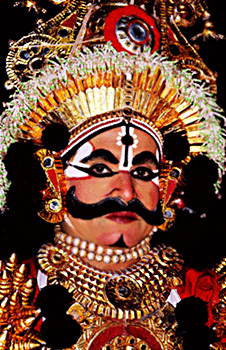 Bhumika or role of people was a vital part in the Indian theatre. The types of people allowed to play roles in the Sanskrit dramas were selected based on their gestures, speech, gait and temperament. Bhumikas or roles were assigned to persons with respect to their personality.
Bhumika or role of people was a vital part in the Indian theatre. The types of people allowed to play roles in the Sanskrit dramas were selected based on their gestures, speech, gait and temperament. Bhumikas or roles were assigned to persons with respect to their personality.
Divine personages were represented by persons whose physiques were well built and who spoke pleasantly. Those, who were fat and tall, whose voice was profound like thunder and who had frightening eyes, eyebrows and faces, were selected for the roles of raksasas, danavas and daityas. The roles of princes were assumed by wise actors, of good look and voice and of honourable disposition. Generals and ministers were played by persons who were brave, clever in conversation and possessed clear vision. Persons, who were slow, dwarfish, hunch backed, of deformed noses or cheekbones, of ugly faces, poorly dressed and ill-tempered, played the parts of servants. Wearied persons were represented by those who were lean and thin, while persons in normal health were represented by fat persons. The characters were represented according to their country, dress and suitable appearance.
In the Indian theatre roles were of three different qualities namely, anurupa, virupa and rupanusarini. Anurupa is that which is represented by an actor of the same age and sex. In Virupa, a child plays the role of an old man or an old man takes the role of a child. In Rupanusarini, a man plays the part of a woman. According to the Natyashastra; there are three modes of representation, roles may be taken by persons of appropriate sex and age; roles of the old may be taken by the young and vice versa. The word bhrukumsa was used to denote a man who was personating a woman. The enactment of women`s roles by men was not by any means the normal practice. Bharata states that women are delicate and hence they should be represented by women alone. Natya should be performed by women well versed in dramaturgic sastra. Roles in sringara sentiment should be left to women because of their delicate (sukumara) gestures and well formed limbs.
Sukumara and Aviddha are two kinds of performances in natya which are followed to present emotions and sentiments. Nataka, prakarana, bhana, vithi and anka are varieties of the delicate (sukumara) type. Aviddha is full of war, motions and agitations. Hence women are discouraged to take part in it. Aviddha performances were generally done by devas, danavas and raksasas who were violent by nature and full of vigour.



















